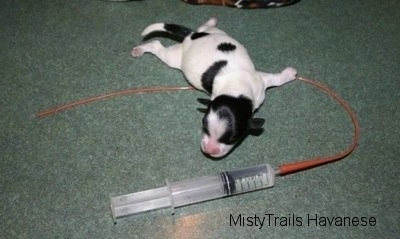
At first this puppy appeared to be healthy. On day one the puppy was noticeably smaller than the others. On day two it had not gained well, which some breeders would ignore, but we tube fed her a couple cc's of canine milk to bring up her energy. By day three there was blood coming out of her butt and we rushed her to the vet. The puppy was not eating, and the vet and I tube fed her some warm water. A test at the vet showed only blood with no stool coming out that end and gives her a slim chance of making it through the night.
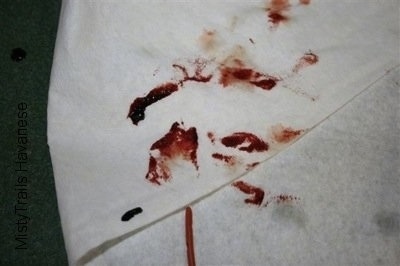
Most breeders would need to leave the pup at the vet at this stage, unless you are capable of bringing the puppy home and keeping her hydrated, in hopes the blood would stop.

Her body was shutting down. One foot was purple, so we massaged it and it came up pink again. We tubed her more warm water. We were still hoping to save this puppy.
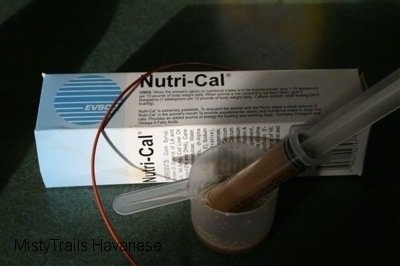
A mixture of Nutri-Cal and warm water is something you can try using to hydrate a sick puppy.
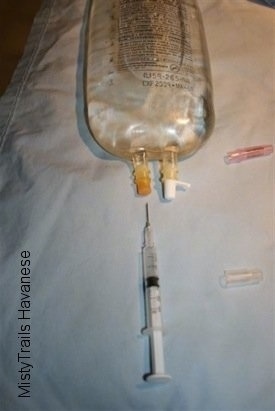
Lactate Ringer’s fluid solution given subcutaneously (under the skin) is one of the best ways to hydrate a puppy.
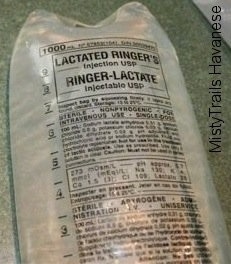
The Lactate Ringer’s must be warmed and NOT injected cold. I heat the bag in the microwave. You do not put COLD fluid into a puppy that you are trying to keep warm. I draw a syringe with the drawing needle (a sterile needle used only as a tester) and squirt it on my wrist. I draw a second test syringe to double-check the temperature of the liquid. Then I remove the test drawing needle and put on the sterile needle I will use for injecting the puppy.

There was not much to be done but to keep her hydrated, warm and tell her how sweet she was. Her tummy was full. There was nowhere for her system to void. We did all we could to give her a chance and make her comfortable. No more blood was coming. We gave her a very mild warm enema to see if we could possibly get the bowels to work. We were beginning to realize the puppy was not going to recover, that it was born underdeveloped. A puppy that is born underdeveloped has a hard time surviving. Mostly it depends on the severity of the defect. This puppy was not pooping.
A puppy needs 1 cc for every ounce of body weight every 2.5 to 4 hours.
If you have never tube fed a puppy before, it is wise to contact your vet for directions. Do not attempt unless you are under the instruction of your own vet. This page is meant for general educational information, and is not meant to replace the advice from one’s vet.
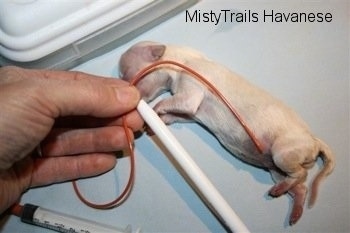
When tube feeding a puppy, measure the length of the puppy from the mouth to the stomach.

Mark the length with a pen so you do not go in too far. Gently feed the tube into the puppy's mouth and down into the stomach. Make sure you go down into the stomach so the pup does not get the liquid into his lungs. On the same note, be sure you don't go too far. It is important to measure before inserting the tube. You must hold the pup's neck straight so the tube can go down easily. Very slowly tube the recommended amount to the puppy.
It is important to make sure there is no air in the syringe and to push the milk up through the tube before inserting it into the puppy to avoid filling the belly with air.
Some people tube in a cc of water first to see if water comes out the nose, as water in the lungs is MUCH EASIER to fix than milk in the lungs, however it is much wiser to make sure you prevent this in the first place.
After inserting the tube and before giving the milk, some vets and breeders hold the puppy up to their ear and listen for breathing from the nose of the puppy, so then they know the tube is in the stomach. Some people find that holding the pup up works best for them. Others really rely on where they marked on the tube to be sure the tube is NOT in the lungs. The tube MUST go all the way in to the pre-marked line.
Tubing for the first few times is stressful and worrisome. You MUST mark your tube well to be sure you go ALL the way in to the stomach. With tubing 1 cc per oz. of body weight of a 4 oz. puppy you tube in 1 cc of water and if that goes well then give 3 cc of milk. Contact your vet for guidance and advice.
After you have tubed for a while you will have the comfort level to not use the water. Some breeders listen to the breathing of a puppy before tubing. I personally rely on the mark on the tube. Remember it is very, VERY important to line your tubes with milk so you are not putting air into the puppy. Air is not too big of a worry, but it can cause gas and some pups get air when they nurse or bottle feed, but it is nicer to avoid putting air into their little tummies as it can cause some discomfort to pass.
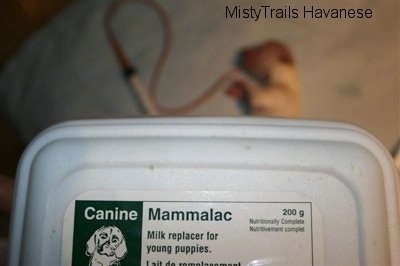
Puppy milk replacer
SubQ hydrating a puppy

Hold the puppy still.

Pinch the neck skin. You want to inject the fluid JUST under the skin.

Inject a bubble very, very slowly.

You want to inject about 1/3 to 1/2 the size of the head of the puppy of fluid under the skin.
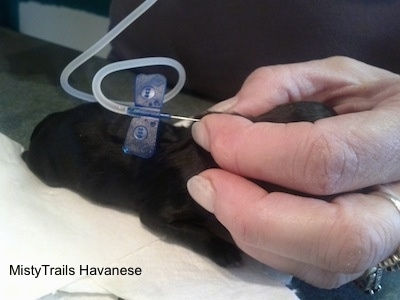
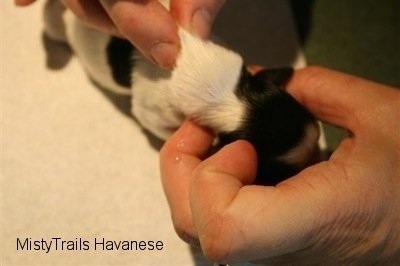
After removing the needle, pinch the skin for 30 seconds.
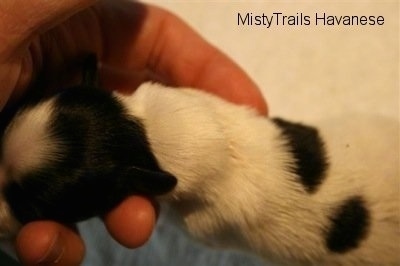
The bubble of fluid will slowly disburse into his body. At first we were hopeful the puppy would recover, however we had found out from the vet she had an underdeveloped intestinal track. And something was seriously wrong.
THINK about what comes with breeding, it is not always cute puppies. This puppy died peacefully on the third evening. When you realize that nothing can be done to save a puppy, humanely putting it to sleep is the best way, and the only fair thing to do for a suffering puppy.
But if there is a chance to save a puppy then it is good to know what to do. Remember, when you decide to breed you may be faced with hard decisions. Always consult with your vet.
Courtesy of MistyTrails Havanese